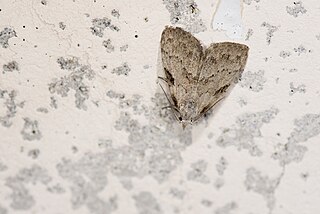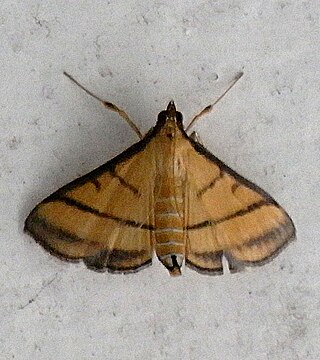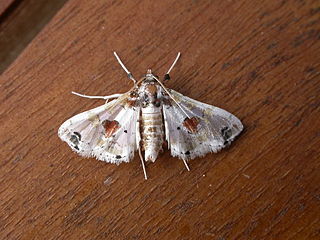
Manoba is a genus of moths in the family Nolidae. The genus was first described by Francis Walker in 1863.

Cnaphalocrocis is a genus of moths of the family Crambidae. The genus was described by Julius Lederer in 1863.
Deuterophysa is a genus of moths of the family Crambidae described by Warren in 1889.

Leucinodes is a genus of moths of the family Crambidae. It was first described by Achille Guenée in 1854.

Massepha is a genus of moths of the family Crambidae.

Pycnarmon is a genus of moths of the family Crambidae described by Julius Lederer in 1863.
Salbia is a genus of moths of the family Crambidae described by Achille Guenée in 1854.

Sufetula is a genus of moths of the family Crambidae.
Eoophyla mimicalis is a moth in the family Crambidae. It was described by George Hampson in 1917. It is found in Cameroon, the Republic of the Congo, the Democratic Republic of the Congo, Ghana, Kenya, Malawi, Nigeria, Sierra Leone, Tanzania and Uganda.
Deuterophysa grisealis is a moth in the family Crambidae. It was described by George Hampson in 1917. It is found in Malawi.
Furcivena dialithalis is a moth in the family Crambidae. It was described by George Hampson in 1917. It is found in Ghana.
Massepha entephriadia is a moth in the family Crambidae. It was described by George Hampson in 1898. It is found in Nigeria.
Massepha flavimaculata is a moth in the family Crambidae. It was described by Max Gaede in 1917. It is found in Equatorial Guinea.
Massepha longipennis is a moth in the family Crambidae. It was described by George Hampson in 1912. It is found in Cameroon.
Massepha tessmanni is a moth in the family Crambidae. It was described by Max Gaede in 1917. It is found in Cameroon and Equatorial Guinea.
Dipleurinodes phaeopalpia is a moth in the family Crambidae. It was described by George Hampson in 1917. It is found in South Africa.
Cangetta albiceps is a moth in the family Crambidae. It was described by George Hampson in 1917. It is found in South Africa.
Bradina flavalis is a moth in the family Crambidae. It was described by George Hampson in 1917. It is found in Cameroon.
Cnaphalocrocis grisealis is a moth in the family Crambidae. It was described by Jean Ghesquière in 1942. It is found in the former provinces of Équateur and Katanga in the Democratic Republic of the Congo.
Dolicharthria grisealis is a moth in the family Crambidae. It was described by George Hampson in 1899. It is found on Socotra in Yemen.




